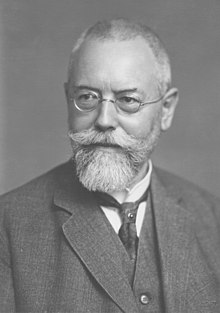August Köhler
| August Köhler | |
|---|---|

August Köhler, ca. 1930
|
|
| Born |
March 4, 1866 Darmstadt, Grand Duchy of Hesse |
| Died | March 12, 1948 (aged 82) Jena, Germany |
| Residence | Germany |
| Nationality | German |
| Fields | Physicist |
| Institutions |
University of Giessen University of Jena Zeiss Optical Works |
| Alma mater |
University of Heidelberg University of Giessen |
| Doctoral advisor | Johann Wilhelm Spengel |
| Known for | Köhler illumination |
| Notable awards | honorary doctor degree of the University of Jena |
August Karl Johann Valentin Köhler (March 4, 1866 – March 12, 1948) was a German professor and early staff member of Carl Zeiss AG in Jena, Germany. He is best known for his development of the microscopy technique of Köhler illumination, an important principle in optimizing microscopic resolution power by evenly illuminating the field of view. This invention revolutionized light microscope design and is widely used in traditional as well as modern digital imaging techniques today.
Köhler was born in 1866 in Darmstadt, Germany, where he attended the Ludwig-Georgs-Gymnasium until 1884. He studied at the Technical University in Darmstadt and at the universities of Heidelberg and Giessen covering a wide range of fields from zoology and botany to mineralogy, physics, and chemistry.
In 1888, August Köhler graduated with a teaching degree and subsequently taught at gymnasiums in Darmstadt and Bingen before going back to university. He started his academic career as a student, instructor and assistant to professor J.W. Spengel at the Zoological Institute at the University of Giessen, Germany. The object of his doctorate thesis was the taxonomy of limpets, a project that depended heavily on microscopic imaging and prompted Köhler into trying to improve the quality of images taken via photomicrography. The result of this work was published in 1893.
After receiving his doctorate degree from the University of Giessen in 1893, Köhler worked a number of years as a grammar school teacher in Bingen. In 1900, he was invited to join the Zeiss Optical Works company in Jena, Germany, by Siegfried Czapski based on his earlier work on improving microscope illumination. He stayed with Zeiss as a physicist for 45 years and became instrumental to the development of modern light microscope design. From 1922 until his retirement in June 1945, he was also professor for microphotometry at the University of Jena. He became honorary professor of the Medical Faculty at the University of Jena in 1922 and received an honorary medical doctor degree in 1934. In 1938, he assumed the head position for the Department of Microscopy, Microphotography and Projection.
...
Wikipedia
